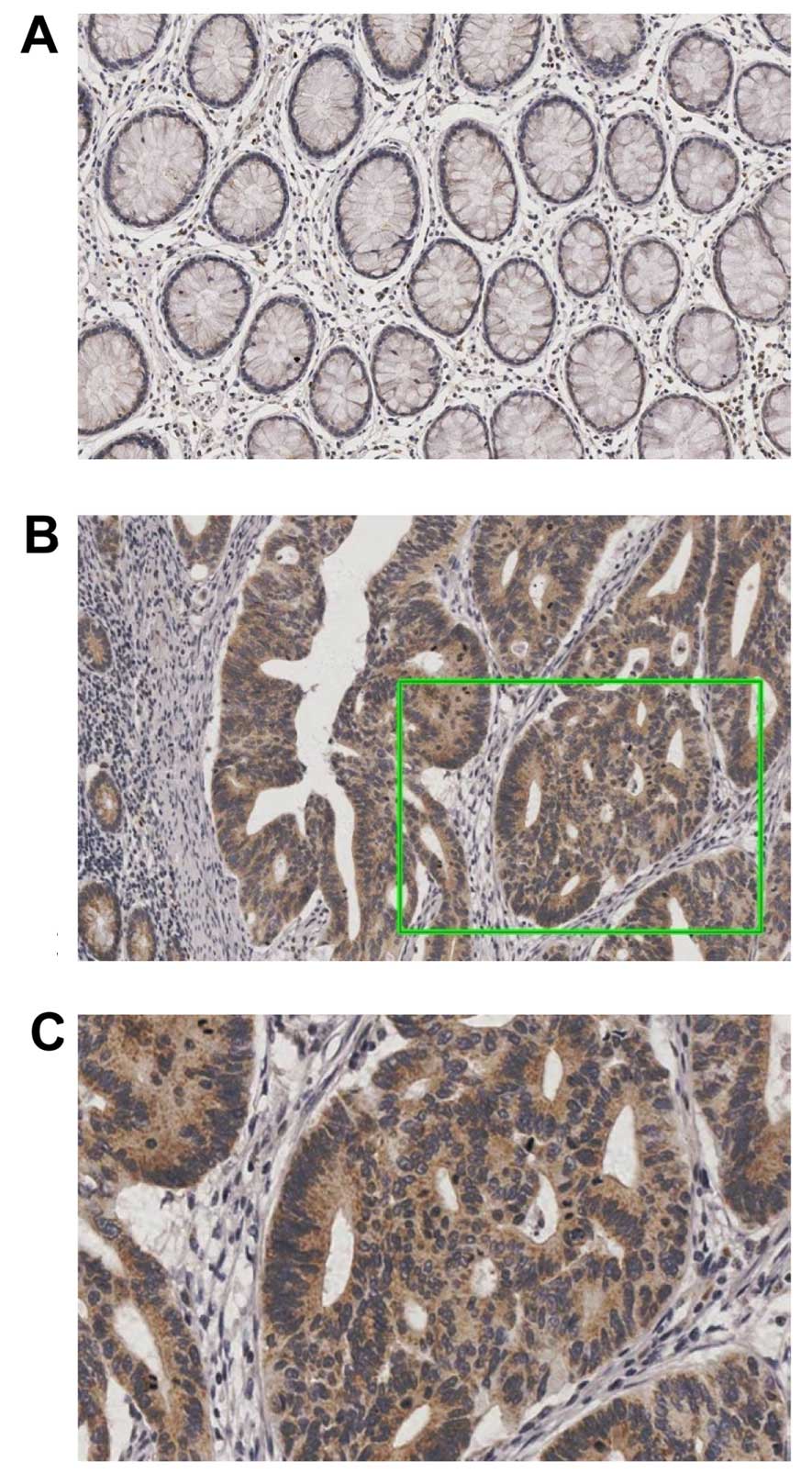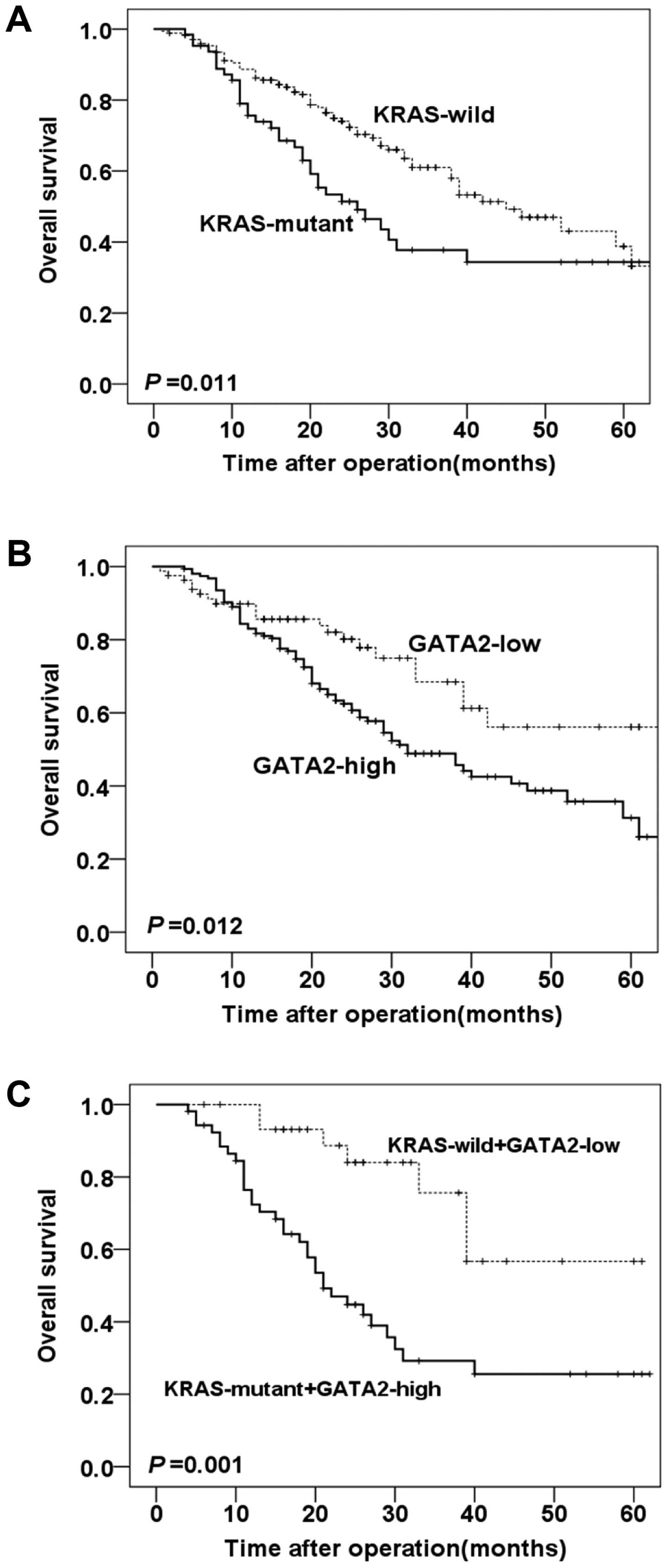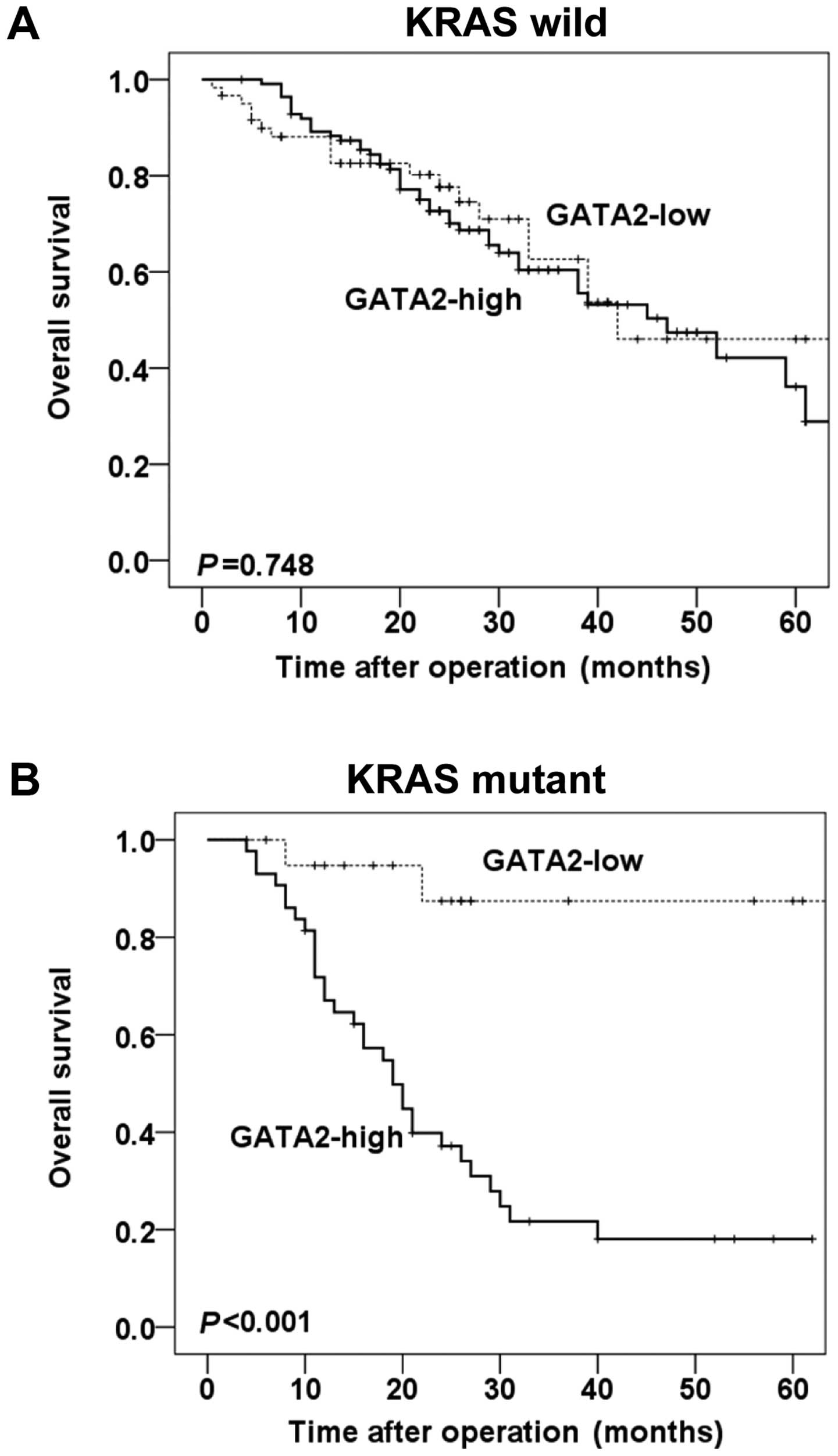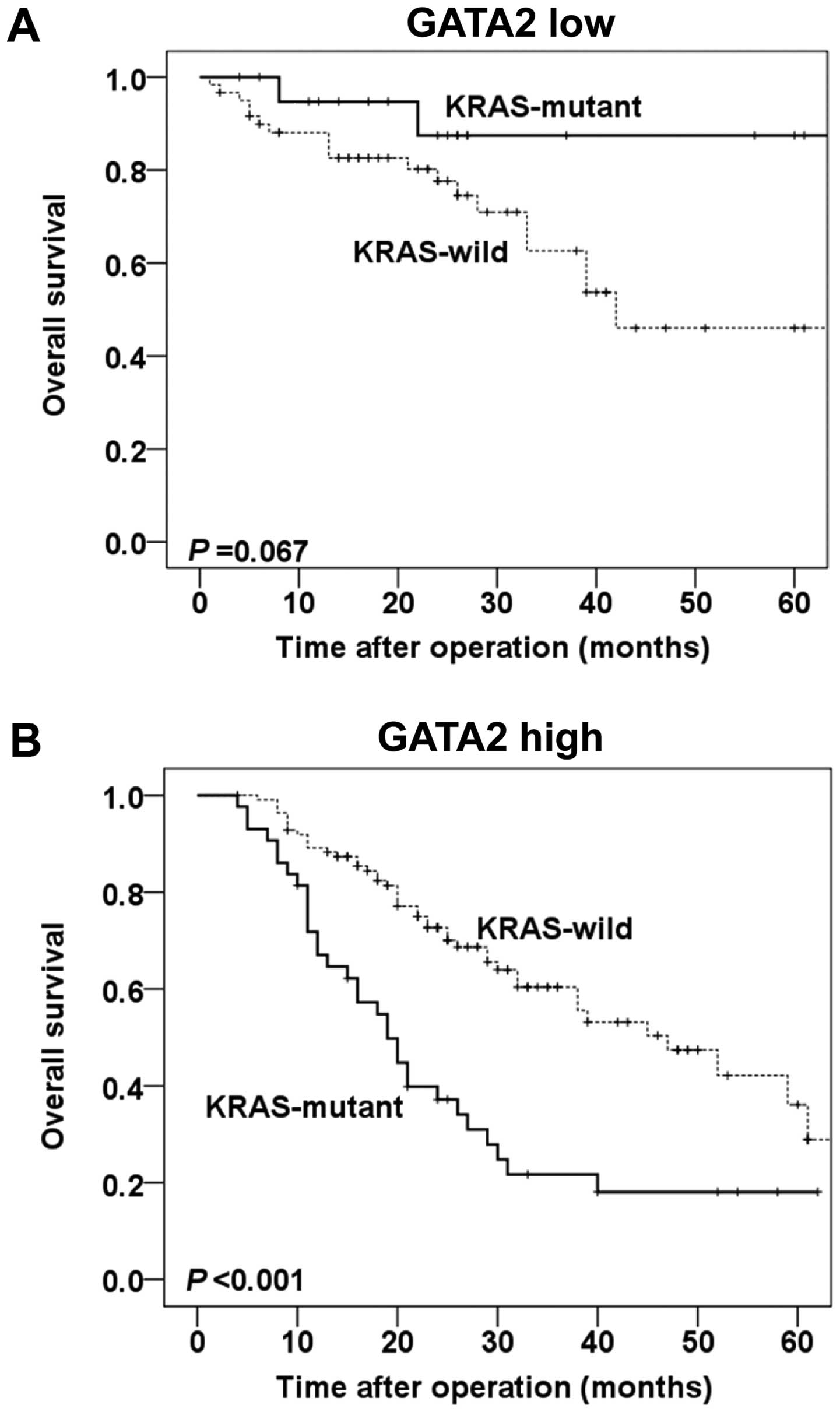GATA binding protein 2 overexpression is associated with poor prognosis in KRAS mutant colorectal cancer
- Authors:
- Published online on: July 21, 2016 https://doi.org/10.3892/or.2016.4961
- Pages: 1672-1678
Abstract
Introduction
Colorectal cancer (CRC) is one of the most prevalent cancers worldwide and the third ranked fatal malignancy in the United States (1,2). Although there has been progress in diagnosis, surgery, combined chemotherapy and targeted therapy (3,4), CRC remains a significant adverse influence on human health with the 5-year survival of only 65% (5). KRAS has long been known as the most frequently mutated gene in nearly all types of cancers. Particularly, approximately 40% of the CRCs harbor a mutation in KRAS (6). Mutations in codons 12 and 13 in exon 2 accounts for 90% of all KRAS mutations, and KRAS gene mutation test has been used as a predictor clinically to determine the lack of efficacy on targeting agents such as cetuximab and panitumumab (7–10). Although still controversial, several studies have demonstrated that KRAS mutation in colorectal carcinoma is correlated to unfavorable survival and enhanced tumor aggressiveness (11,12). However, recent therapeutic targeting of RAS in CRC has proven intractable, due to frequent mutation in KRAS (13). Therefore, searching for new therapeutic targets within the RAS signaling network is necessary and strongly warranted.
GATA binding protein 2 (GATA2), a key member of zinc finger transcription factors family, is identified as a critical regulator of growth, differentiation and survival of hematopoietic stem cells (14–16). Increasing evidence has shown that GATA2 expression is correlated with hematologic pathophysiologies and the proliferation and progression of solid tumors (17–23). It was reported that overexpression of GATA2 would contribute to the development of breast cancer through negatively regulating the transcription of phosphatase and tensin homologue (PTEN) (20). As for prostate cancer, upregulated GATA2 expression has been reported to be correlated with tumor progression and GATA2 has been suggested to be a pioneer factor in the regulation of androgen receptor related genes (21,22).
Kumar et al demonstrated that RAS-pathway mutant non-small cell lung cancer (NSCLC) cells depended on GATA2 for viability and regulation of the GATA2-related signaling pathways remarkably provoking regression of NSCLC (24). Further studies proved that delivery of GATA2 siRNA with selected carrier downregulated GATA2 expression and caused pronounced synthetic lethal effect of NSCLC in vivo (25). However, the association between KRAS mutation and GATA2 expression and its prognostic value in CRC remains unexplored.
In this study, we performed immunohistochemistry to examine GATA2 expression and dideoxy sequencing to detect KRAS mutation in the same patients in a CRC cohort. We demonstrated that GATA2 was a prospective indicator for poor prognosis in KRAS mutant CRC patients and GATA2-related pathways may be potential new therapeutic targets for KRAS mutant CRC patients.
Materials and methods
Ethics statement
All procedures performed in studies involving human participants were in accordance with the Ethical Standards of the Research Ethics Committee of Peking University Cancer Hospital and Institute (Beijing, China) (no. 2012071710) and with the 1964 Helsinki Declaration and its later amendments or comparable ethical standards.
Patients and tissue specimens
This retrospective study included a total of 236 patients who were diagnosed with CRC and then received primary tumor resection at the Department of Gastrointestinal Surgery IV, Peking University Cancer Hospital and Institute from 2005 to 2012. All the CRC tissues for immunochemistry analysis were obtained from surgically removed tumors and routinely embedded in paraffin. The clinicopathological characteristics and tumor stages were estimated in accordance with the American Joint Committee on Cancer (AJCC) classification guidelines. Postoperative follow-up results were available for all the 236 patients who have been followed up until March 2015. For the utility of these clinical samples for research, prior written informed consent of the patients and approval from the Research Ethics Committee of Peking University Cancer Hospital and Institute, (Beijing, China) were obtained.
KRAS mutation detection
Formalin-fixed, paraffin-embedded (FFPE) samples with ≥50% tumor cells were collected from patients mentioned above. After extracting genome DNA from the FFPE samples, fragments contained codons 12 and 13 in KRAS exon 2 were amplified by PCR (KRAS forward, 5′-GGTACTGGTGGAGTATTTGATAG-3′ and reverse, 5′-TGGTCCTGCACCAGTAATATG-3′). LA Taq polymerase was used to perform the PCR. The product size was 248 bp. The reaction mixtures recommended by the manufacturers were used. The initial denaturation step was 5 min at 94°C. The thermal profile was 45 cycles of 94°C for 30 sec, 56°C for 30 sec and 72°C for 20 sec. The final elongation was 10 min at 72°C. The PCR products were separated on 1% agarose gel electrophoresis and then sequenced using the same forward primer by Invitrogen 3730XL genetic analyzer. The sequencing results were analyzed with Chromas software under the condition of signal/noise >98% (26).
Immunohistochemistry
Paraffin-embedded tumor tissue blocks were cut 4-µm thick and then baked overnight at 72°C. Then they were deparaffinized with xylene twice and rehydrated with graded ethanol. The slides were heated in antigen retrieval buffer containing 0.01 M sodium citrate-hydrochloric acid (pH 6.0) for 10 min in a high pressure apparatus at 150°C. After having been cooled in room temperature for 1 h, the slides were treated with 3% hydrogen peroxide to inhibit endogenous peroxidase activity. After blocking nonspecific binding with goat serum, the sections were incubated with a rabbit polyclonal antibody against GATA2 (1:200; Santa Cruz Biotechnology) at 4°C overnight, followed by incubation with second antibody from the EnVision™ kit (Dako Cytomation) at room temperature for 30 min. The visualization signal was developed with diaminobenzidine (Sigma). Sections were counterstained with hematoxylin.
Evaluation of GATA2 immunohistochemistry
GATA2 staining scores were determined independently by two pathologists previously uninformed about the histopathological features and patient information to minimize subjectivity. Proportion of positive cells and staining intensity of immunohistochemistry were considered in the scoring process. The scores for GATA2 staining were determined according to the following standard (27): −, no staining or <10% positive cells; +, 10–20% weakly to moderately positive cells; ++, 10–20% intensively positive cells or 20–50% weakly positive cells; and +++, 20–50% positive cells with moderate to strong reactivity or >50% positive cells. All disagreements on results between the two pathologists were resolved after joint review and finally consensus was achieved for all the results.
Statistical analysis
Statistical analysis was carried out using SPSS software 17.0. The Pearson's χ2 verified the correlation between either KRAS gene status or GATA2 expression and clinicopathological parameters. Kaplan-Meier method was used to estimate overall survival curve and differences between groups were compared by the log-rank test. Univariate and multivariate Cox proportional hazard regression models were used to evaluate the predictors for overall survival. A p-value of <0.05 was considered to be statistically significant.
Results
Types of KRAS mutation
Among the 236 enrolled cases, 64 (27.1%) were found to harbor mutations in the KRAS gene. As shown in Table I, the KRAS mutations were distributed between codon 12 [51/64 (79.7%)] and codon 13 [13/64 (20.3%)]. A total of seven types of mutation in exon 2 were detected. The G>A transitions at nucleotides, namely C12GAT and C12AGT in codon 12 as well as C13GAC in codon 13, were the most frequent mutations in this cohort (70.3%).
Association between KRAS mutation or GATA2 expression and clinicopathological features
All 236 patients with CRC were included in this analysis. GATA2 expression was examined in all of the 236 CRC patients (Fig. 1). Table II shows the correlation between either KRAS mutation or GATA2 expression and various clinicopathological features. Statistical analysis indicated that KRAS mutation was significantly correlated with gender (P=0.011), tumor location (P=0.024) and overall survival (P=0.012). Nevertheless, no associations were found between KRAS mutation and age, tumor size, depth of invasion, lymph node metastasis, TNM stage, histological type, and tumor differentiation (P>0.05). On the other hand, GATA2 expression was significantly linked with age (P=0.012), depth of invasion (P=0.002), lymph node metastasis (P=0.018), TNM stage (P=0.001) and overall survival (P=0.001). No correlation was observed between the level of GATA2 expression and gender, tumor location, tumor size, histological type, and tumor differentiation (P>0.05). However, KRAS mutation was not significantly associated with GATA2 expression (P=0.766).
Table IICorrelations between KRAS mutation or GATA2 expression and clinicopathological features in colorectal cancer patients. |
Correlation between KRAS mutation or GATA2 expression and overall survival
Kaplan-Meier survival curves with log-rank test were performed to evaluate the association between KRAS mutation or GATA2 expression level and prognosis. The results revealed that KRAS mutation in CRC was significantly associated with worse overall survival (P=0.011, Fig. 2A). Additionally, GATA2 high expression was significantly correlated with shorter overall survival compared with GATA2 low expression group (P=0.012, Fig. 2B).
For further analysis, the CRC patients enrolled were separated into different groups according to KRAS status (wild-type and mutant) and GATA2 expression (low and high). The Kaplan-Meier curves in Fig. 2C demonstrated that KRAS mutant/GATA2 high cancers had poor (P=0.001, Fig. 2C) long-term clinical outcomes in comparison with KRAS wild/GATA2 low cancers.
Stratified analysis by KRAS mutation (KRAS wild-type and KRAS mutant type) showed that in the wild-type KRAS subgroup, no statistical significance was observed between the levels of GATA2 expression and overall survival of CRC patients (P=0.748, Fig. 3A). However, in the mutant KRAS subgroup, patients with high expression of GATA2 experienced significantly shorter overall survival, compared with those with low expression of GATA2 (P<0.001, Fig. 3B).
Furthermore, the prognostic value of KRAS gene status in different GATA2 protein expression levels were also evaluated. In patients with low GATA2 expression, only a borderline significance was observed in overall survival between KRAS wild-type and KRAS mutant groups (P=0.067, Fig. 4A). Whereas in patients with high GATA2 expression, mutant KRAS was significantly correlated with poor overall survival, compared with wild-type KRAS (P=0.020, Fig. 4B).
Cox proportional hazard regression analysis demonstrated GATA2 as an independent prognostic factor
In the univariate analysis, patients with KRAS mutation or GATA-high carcinoma tended to have a shorter overall survival (HR 1.704; 95% CI 1.123–2.583; P=0.012, HR 1.818; 95% CI 1.129–2.927; P=0.014, respectively, Table III) than those with KRAS wild-gene type or GATA2-low tumors. Gender, tumor location, tumor size, depth of tumor invasion and TNM stage also showed significant associations with overall survival in univariate analysis (HR 1.639; 95% CI 1.102–2.437; P=0.015, HR 1.663; 95% CI 1.097–2.521; P=0.017, HR 1.586; 95% CI 1.066–2.359; P=0.023, HR 2.575; 95% CI 1.193–5.559; P=0.016, HR 3.447; 95% CI 1.832–6.488; P<0.001, respectively, Table III). In the multivariate analysis, the potential risk factors mentioned above were included into the Cox proportional hazard regression model in order to avoid covariation. The results showed that GATA2 high expression, advanced TNM stage (III/IV) and female patients were retained as independent prognostic factors for poor prognosis (HR 1.645; 95% CI 1.004–2.696; P=0.048, HR 3.058; 95% CI 1.594–5.865; P=0.001, HR 1.519; 95% CI 1.010–2.283; P=0.045, Table III).
Table IIIUnivariate and multivariate analysis of KRAS status and GATA2 expression with respect to overall survival. |
Discussion
In this study, we analyzed the influence of KRAS mutation and GATA2 expression on the overall survival based on a cohort of CRC patients. Our data demonstrated that although there was no significant correlation between KRAS mutation and expression of GATA2, high level of GATA2 expression and KRAS mutation were significantly associated with unfavorable prognosis in CRC patients, compared to those bearing GATA2-low and wild-type KRAS tumors, respectively. Moreover, we determined that combined KRAS mutation and overexpression of GATA2 led to more adverse overall survival possible independent predictor for poor overall survival in CRC patients. The results in all showed that high levels of GATA2 expression predicted significant adverse clinical outcomes when KRAS mutation occurred in the same patient, suggesting GATA2 protein may be prone to tumorigenesis of KRAS mutant CRC.
The role of GATA2 in hematopoietic malignant disorders has been well elucidated (15,19). In contrast, only a few studies in gastrointestinal malignancies involving GATA2 transcription factor have been done (28). Previous studies suggested that GATA2 expression had influence on the clinical outcomes in patients with several solid carcinomas, such as breast, prostate, colorectal, renal and hepatocellular carcinoma (20–23,29,30). High levels of GATA2 expression predict tumor recurrence, metastasis, or poor survival except for renal and hepatic cancer (29,30). Moreover, the role of GATA2 in lung cancer remains controversial. A recent study demonstrated that GATA2 levels were indispensable for survival of KRAS mutant NSCLC cells (24). Co-inhibition of GATA2-regulated proteasome and Rho-signaling pathway significantly suppressed the proliferation of lung tumor cells with KRAS mutation. These results indicated that application of novel strategy targeting GATA2 related pathways may benefit patients with RAS pathway mutated NSCLC. On the contrary, Tessema et al reported that GATA2 was not requisite for the survival of lung cancer patients with KRAS mutation due to epigenetic repression (31). Therefore, it is critical to determine the association between KRAS mutation and GATA2 expression, and verify their clinical significance in CRC patients. Consistent with previous studies (23,24), our findings showed that GATA2 played a crucial role in the long-term outcomes of CRC patients with KRAS mutation, which raised the possibility that GATA2 protein may influence carcinogenesis and proliferation of KRAS mutant CRC cells. Accordingly, GATA2 could be a potential target for the treatment of CRC patients with KRAS mutation, which indicates resistance to EGFR-targeting antibodies, including cetuximab and panitumumab. However, GATA2 is traditionally considered to be undruggable (32). Thus, therapies against GATA2-regulated pathways may become an alternative strategy for the treatment of CRC patients with KRAS mutation.
In this cohort, as expected, TNM stage was identified as an independent prognostic factor to predict patient clinical outcomes (HR 3.058; 95% CI 1.594–5.865; P=0.001, Table III). Additionally, female gender was observed as an adverse factor in our study (HR 1.519; 95% CI 1.010–2.283; P=0.045, Table III), which was in accordance with previous studies (33).
However, potential limitations still exist in this study. To validate the role of GATA2 expression in CRC patients harboring KRAS mutation, replication cohorts containing detailed clinical data are required. In addition, further functional studies are needed to understand the role of GATA2 and KRAS in CRC.
In conclusion, we demonstrated that elevated GATA2 expression correlated with poor overall survival in CRC patients. Furthermore, GATA2 overexpression in combination with KRAS mutation is significantly associated with poor prognosis. Our results suggested that GATA2 is a promising predictor to identify individuals with worse long-term clinical outcomes, especially in KRAS mutant CRC patients. Also, we consider GATA2-related pathways as potential targets for the development of novel therapies for KRAS mutant CRC.
Acknowledgments
We thank Dr Bin Dong for histopathological diagnosis. This study was supported by the National Natural Science Foundation of China (no. 81272766 and 81450028), the National High Technology Research and Development Program of China (863 Program, no. 2014AA020603), Beijing Natural Science Foundation (no. 7162039). Beijing Municipal Administration of Hospitals Clinical Medicine Development of Special Funding Support (no. XM201309), Peking University (PKU) 985 Special Funding for Collaborative Research with PKU Hospitals (to X.S. and Fan Bai).
Abbreviations:
|
CRC |
colorectal cancer |
|
GATA2 |
GATA2-binding protein 2 |
|
EGFR |
epidermal growth factor receptor |
|
NSCLC |
non-small cell lung cancer |
|
DFS |
disease-free survival |
|
PTEN |
phosphatase and tensin homologue |
|
FFPE |
formalin-fixed, paraffin-embedded |
|
PCR |
polymerase chain reaction |
References
|
DeSantis CE, Lin CC, Mariotto AB, Siegel RL, Stein KD, Kramer JL, Alteri R, Robbins AS and Jemal A: Cancer treatment and survivorship statistics, 2014. CA Cancer J Clin. 64:252–271. 2014. View Article : Google Scholar : PubMed/NCBI | |
|
Siegel R, Desantis C and Jemal A: Colorectal cancer statistics, 2014. CA Cancer J Clin. 64:104–117. 2014. View Article : Google Scholar : PubMed/NCBI | |
|
Ahmed S, Johnson K, Ahmed O and Iqbal N: Advances in the management of colorectal cancer: From biology to treatment. Int J Colorectal Dis. 29:1031–1042. 2014. View Article : Google Scholar : PubMed/NCBI | |
|
De Rosa M, Pace U, Rega D, Costabile V, Duraturo F, Izzo P and Delrio P: Genetics, diagnosis and management of colorectal cancer (Review). Oncol Rep. 34:1087–1096. 2015.PubMed/NCBI | |
|
Siegel RL, Miller KD and Jemal A: Cancer statistics, 2015. CA Cancer J Clin. 65:5–29. 2015. View Article : Google Scholar : PubMed/NCBI | |
|
Macedo MP, Andrade LB, Coudry R, Crespo R, Gomes M, Lisboa BC, Aguiar S Jr, Soares FA, Carraro DM and Cunha IW: Multiple mutations in the Kras gene in colorectal cancer: Review of the literature with two case reports. Int J Colorectal Dis. 26:1241–1248. 2011. View Article : Google Scholar : PubMed/NCBI | |
|
Karapetis CS, Khambata-Ford S, Jonker DJ, O'Callaghan CJ, Tu D, Tebbutt NC, Simes RJ, Chalchal H, Shapiro JD, Robitaille S, et al: K-ras mutations and benefit from cetuximab in advanced colorectal cancer. N Engl J Med. 359:1757–1765. 2008. View Article : Google Scholar : PubMed/NCBI | |
|
Amado RG, Wolf M, Peeters M, Van Cutsem E, Siena S, Freeman DJ, Juan T, Sikorski R, Suggs S, Radinsky R, et al: Wild-type KRAS is required for panitumumab efficacy in patients with metastatic colorectal cancer. J Clin Oncol. 26:1626–1634. 2008. View Article : Google Scholar : PubMed/NCBI | |
|
De Roock W, De Vriendt V, Normanno N, Ciardiello F and Tejpar S: KRAS, BRAF, PIK3CA, and PTEN mutations: Implications for targeted therapies in metastatic colorectal cancer. Lancet Oncol. 12:594–603. 2011. View Article : Google Scholar | |
|
Inoue Y, Saigusa S, Iwata T, Okugawa Y, Toiyama Y, Tanaka K, Uchida K, Mohri Y and Kusunoki M: The prognostic value of KRAS mutations in patients with colorectal cancer. Oncol Rep. 28:1579–1584. 2012.PubMed/NCBI | |
|
Arrington AK, Heinrich EL, Lee W, Duldulao M, Patel S, Sanchez J, Garcia-Aguilar J and Kim J: Prognostic and predictive roles of KRAS mutation in colorectal cancer. Int J Mol Sci. 13:12153–12168. 2012. View Article : Google Scholar : PubMed/NCBI | |
|
Kadowaki S, Kakuta M, Takahashi S, Takahashi A, Arai Y, Nishimura Y, Yatsuoka T, Ooki A, Yamaguchi K, Matsuo K, et al: Prognostic value of KRAS and BRAF mutations in curatively resected colorectal cancer. World J Gastroenterol. 21:1275–1283. 2015. View Article : Google Scholar : PubMed/NCBI | |
|
Sameen S, Barbuti R, Milazzo P, Cerone A, Del Re M and Danesi R: Mathematical modeling of drug resistance due to KRAS mutation in colorectal cancer. J Theor Biol. 389:263–273. 2016. View Article : Google Scholar | |
|
Collin M, Dickinson R and Bigley V: Haematopoietic and immune defects associated with GATA2 mutation. Br J Haematol. 169:173–187. 2015. View Article : Google Scholar : PubMed/NCBI | |
|
Tsai FY and Orkin SH: Transcription factor GATA-2 is required for proliferation/survival of early hematopoietic cells and mast cell formation, but not for erythroid and myeloid terminal differentiation. Blood. 89:3636–3643. 1997.PubMed/NCBI | |
|
Ohmori S, Moriguchi T, Noguchi Y, Ikeda M, Kobayashi K, Tomaru N, Ishijima Y, Ohneda O, Yamamoto M and Ohneda K: GATA2 is critical for the maintenance of cellular identity in differentiated mast cells derived from mouse bone marrow. Blood. 125:3306–3315. 2015. View Article : Google Scholar : PubMed/NCBI | |
|
Nandakumar SK, Johnson K, Throm SL, Pestina TI, Neale G and Persons DA: Low-level GATA2 overexpression promotes myeloid progenitor self-renewal and blocks lymphoid differentiation in mice. Exp Hematol. 43:565–577. e1–10. 2015. View Article : Google Scholar : PubMed/NCBI | |
|
Hsu AP, McReynolds LJ and Holland SM: GATA2 deficiency. Curr Opin Allergy Clin Immunol. 15:104–109. 2015. View Article : Google Scholar : | |
|
Vicente C, Conchillo A, García-Sánchez MA and Odero MD: The role of the GATA2 transcription factor in normal and malignant hematopoiesis. Crit Rev Oncol Hematol. 82:1–17. 2012. View Article : Google Scholar | |
|
Wang Y, He X, Ngeow J and Eng C: GATA2 negatively regulates PTEN by preventing nuclear translocation of androgen receptor and by androgen-independent suppression of PTEN transcription in breast cancer. Hum Mol Genet. 21:569–576. 2012. View Article : Google Scholar | |
|
Vidal SJ, Rodriguez-Bravo V, Quinn SA, Rodriguez-Barrueco R, Lujambio A, Williams E, Sun X, de la Iglesia-Vicente J, Lee A, Readhead B, et al: A targetable GATA2-IGF2 axis confers aggressiveness in lethal prostate cancer. Cancer Cell. 27:223–239. 2015. View Article : Google Scholar : PubMed/NCBI | |
|
Wu D, Sunkel B, Chen Z, Liu X, Ye Z, Li Q, Grenade C, Ke J, Zhang C, Chen H, et al: Three-tiered role of the pioneer factor GATA2 in promoting androgen-dependent gene expression in prostate cancer. Nucleic Acids Res. 42:3607–3622. 2014. View Article : Google Scholar : PubMed/NCBI | |
|
Chen L, Jiang B, Wang Z, Liu M, Ma Y, Yang H, Xing J, Zhang C, Yao Z, Zhang N, et al: Expression and prognostic significance of GATA-binding protein 2 in colorectal cancer. Med Oncol. 30:4982013. View Article : Google Scholar : PubMed/NCBI | |
|
Kumar MS, Hancock DC, Molina-Arcas M, Steckel M, East P, Diefenbacher M, Armenteros-Monterroso E, Lassailly F, Matthews N, Nye E, et al: The GATA2 transcriptional network is requisite for RAS oncogene-driven non-small cell lung cancer. Cell. 149:642–655. 2012. View Article : Google Scholar : PubMed/NCBI | |
|
Shen S, Mao CQ, Yang XZ, Du XJ, Liu Y, Zhu YH and Wang J: Cationic lipid-assisted polymeric nanoparticle mediated GATA2 siRNA delivery for synthetic lethal therapy of KRAS mutant non-small-cell lung carcinoma. Mol Pharm. 11:2612–2622. 2014. View Article : Google Scholar : PubMed/NCBI | |
|
Gao J, Li YY, Sun PN and Shen L: Comparative analysis of dideoxy sequencing, the KRAS StripAssay and pyrosequencing for detection of KRAS mutation. World J Gastroenterol. 16:4858–4864. 2010. View Article : Google Scholar : PubMed/NCBI | |
|
Xing X, Peng L, Qu L, Ren T, Dong B, Su X and Shou C: Prognostic value of PRL-3 overexpression in early stages of colonic cancer. Histopathology. 54:309–318. 2009. View Article : Google Scholar : PubMed/NCBI | |
|
Ayanbule F, Belaguli NS and Berger DH: GATA factors in gastrointestinal malignancy. World J Surg. 35:1757–1765. 2011. View Article : Google Scholar : PubMed/NCBI | |
|
Peters I, Dubrowinskaja N, Tezval H, Kramer MW, von Klot CA, Hennenlotter J, Stenzl A, Scherer R, Kuczyk MA and Serth J: Decreased mRNA expression of GATA1 and GATA2 is associated with tumor aggressiveness and poor outcome in clear cell renal cell carcinoma. Target Oncol. 10:267–275. 2015. View Article : Google Scholar | |
|
Li YW, Wang JX, Yin X, Qiu SJ, Wu H, Liao R, Yi Y, Xiao YS, Zhou J, Zhang BH, et al: Decreased expression of GATA2 promoted proliferation, migration and invasion of HepG2 in vitro and correlated with poor prognosis of hepatocellular carcinoma. PLoS One. 9:e875052014. View Article : Google Scholar : PubMed/NCBI | |
|
Tessema M, Yingling CM, Snider AM, Do K, Juri DE, Picchi MA, Zhang X, Liu Y, Leng S, Tellez CS, et al: GATA2 is epigenetically repressed in human and mouse lung tumors and is not requisite for survival of KRAS mutant lung cancer. J Thorac Oncol. 9:784–793. 2014. View Article : Google Scholar : PubMed/NCBI | |
|
Darnell JE Jr: Transcription factors as targets for cancer therapy. Nat Rev Cancer. 2:740–749. 2002. View Article : Google Scholar : PubMed/NCBI | |
|
Kim SE, Paik HY, Yoon H, Lee JE, Kim N and Sung MK: Sex- and gender-specific disparities in colorectal cancer risk. World J Gastroenterol. 21:5167–5175. 2015. View Article : Google Scholar : PubMed/NCBI |













